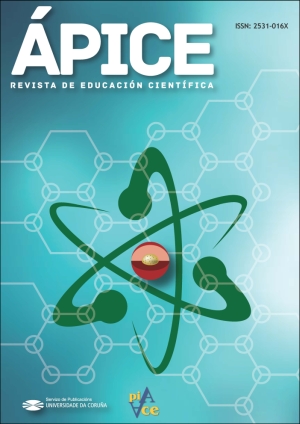A teaching proposal for the construction of a precursor model of air in early childhood education
Main Article Content
Abstract
Keywords:
Downloads
Article Details
References
BAzizoğlu, N., y Geban, Ö. (2016). Students’ preconceptions and misconceptions about gases. Balıkesir Üniversitesi Fen Bilimleri Enstitüsü Dergisi, 6(1), 73-78.
Benlloch, M. (1992). Ciencias en el parvulario: Una propuesta psicopedagógica para el ámbito de la experimentación. Barcelona: Paidós.
Cabello, M. J. (2011). Ciencia en la educación infantil: La importancia de un “rincón de observación y experimentación” o “de los experimentos” en nuestras aulas. Pedagogía Magna, 10, 58-63.
Canedo-Ibarra, S. P., Castelló-Escandell, J., García-Wehrle, P., Gómez-Galindo, A. y Morales-Blake, A. R. (2012). Cambio conceptual y construcción de modelos científicos precursores en educación infantil. Revista Mexicana de Investigación Educativa, 17(54), 691-727.
Cañal, P. (2006). La alfabetización científica en la infancia. Aula de infantil, 33, 5-9.
Cañal, P., García-Carmona, A. y Cruz-Guzmán, M. (2016). Didáctica de las ciencias experimentales en educación primaria. Madrid: Paraninfo.
Christidou, V. (2005). Accounting for Natural Phenomena. International Journal of Learning, 12(8), 21-28.
Christidou, V. y Hatzinikita, V. (2006). Preschool children’s explanations of plant growth and rain formation: A comparative analysis. Research in Science Education, 36(3), 187–210. DOI: https://doi.org/10.1007/s11165-005-9006-1
Demirbaş, M. y Ertuğrul, N. (2014). A study on preschoolers' conceptual perceptions of states of matter: A case study of Turkish students. South African Journal of Education, 34(3), 01-13. DOI: http://doi.org/10.15700/201409161115
Driver, R. (1988). Un enfoque constructivista para el desarrollo del currículo en ciencias. Enseñanza de las ciencias, 6(2), 109-120.
Eshach, H. y Fried, M. N. (2005). Should science be taught in Early Childhood? Journal of Science Education and Technology, 14(3), 315-336. DOI: https://doi.org/10.1007/s10956-005-7198-9
García-Carmona, A., Criado, A. M. y Cañal, P. (2014). Alfabetización científica en la etapa 3-6 años: Un análisis de la regulación estatal de enseñanzas mínimas. Enseñanza de las Ciencias, 32(2), 131–149. DOI: https://doi.org/10.5565/rev/ensciencias.817
Garrido, A. (2016). Modelització I models en la formació inicial de mestres de primària des de la perspectiva de la pràctica científica. Tesis doctoral. Bellaterra: Universitat Autònoma de Barcelona.
Gelman, R. y Brenneman, K. (2004). Science learning pathways for young children. Early Childhood Research Quarterly, 19, 150-158. DOI: https://doi.org/10.1016/j.ecresq.2004.01.009
Giere, R. N. (2004). How models are used to represent reality. Philosophy of science, 71(5), 742-752. DOI: https://doi.org/10.1086/425063
Greca, I. M. y Moreira, M. A. (2000). Mental models, conceptual models, and modelling. International Journal of Science Education, 22(1), 1-11. DOI: https://doi.org/10.1080/095006900289976
Harlen, W. (2008). Science as a key component of the primary curriculum: A rationale with policy implications. Primary Science, 1, 4-18.
Hesse, J. J. y Anderson, C. W. (1992). Students’ conceptions of chemical change. Journal of Research in Science Teaching, 29(3), 277-299. DOI: https://doi.org/10.1002/tea.3660290307
Hickling, A. K. y Wellman, H. M. (2001). The emergence of children’s causal explanations and theories: Evidence from everyday conversation. Developmental Psychology, 37(5), 668-683. DOI: http://dx.doi.org/10.1037/0012-1649.37.5.668
Jin, H., Hokayem, H., Wang, S. y Wei, X. (2016). A US-China interview study: Biology students’ argumentation and explanation about energy consumption issues. International Journal of Science and Mathematics Education, 14, 1037-1057. DOI: https://doi.org/10.1007/s10763-015-9651-4
Koliopoulos, D., Christidou, V., Symidala, I. y Koutsiouba, M. (2009). Pre-energy reasoning in preschool children. Review of Science, Mathematics and ICT Education, 3(1), 123–140.
Koliopoulos, D., Tantaros, S., Papandreou, M. y Ravanis, K. (2004). Preschool children’s ideas about floating: A qualitative approach. Journal of Science Education, 5(1), 21-24.
Mazas, B., Gil-Quílez, M. J., Martínez-Peña, B., Hervas, A. y Muñoz, A. (2018). Los niños y las niñas de infantil piensan, actúan y hablan sobre el comportamiento del aire y del agua. Enseñanza de las Ciencias, 36(1), 163-180.
Meheut, M., Saltiel, E., y Tiberghien, A. (1985). Pupils’ (11-12 year olds) conceptions of combustion. European Journal of Science Education, 7(1), 83-93. DOI: https://doi.org/10.1080/0140528850070109
Novick, S., y Nussbaum, J. (1981). Pupils’ understanding of the particulate nature of matter: A cross age study. Science Education, 65(2), 187-196. DOI: https://doi.org/10.1002/sce.3730650209
Patton, M. Q. (2002). Qualitative research and evaluation. Thousand Oaks: Sage.
Peterson, S. M. y French, L. (2008). Supporting young children’s explanations through inquiry science in preschool. Early Childhood Research Quarterly, 23(3), 395-408. DOI: https://doi.org/10.1016/j.ecresq.2008.01.003
Piaget, J. (1929). The child’s conception of the world. London: Routledge.
Piaget, J. (1934). La causalidad física en el niño. Madrid: Espasa-Calpe
Richards, R. (1990). An early start to technology from science. London: Simon & Schuster.
Saçkes, M., Flevares, L. M. y Trundle, K. C. (2010). Four-to six-year-old children's conceptions of the mechanism of rainfall. Early Childhood Research Quarterly, 25(4), 536-546. DOI: https://dx.doi.org/10.1016/j.ecresq.2010.01.001
Sanmartí, N. (1995). Aprenen Ciències els més petits. Revista Infància, 85, 8-11.
Séré, M. G. (1986). Children’s conceptions of the gaseous state prior to teaching. European Journal of Science Teaching, 8(4), 413-425. DOI: https://doi.org/10.1080/0140528860080408
Stavy, R. (1988). Children’s conception of gas. International Journal of Science Education, 10(5), 553-560. DOI: https://doi.org/10.1080/0950069880100508
Stavy, R. (1990). Children’s conceptions of changes in the state of matter. From liquid (or solid) to gas. Journal of Research in Science Teaching, 27(3), 247-266. DOI: https://doi.org/10.1002/tea.3660270308
Throop, S. (1982). Actividades preescolares: Ciencias físicas y naturales. Barcelona: CEAC.
Tissandier, G. (1981). Las recreaciones científicas o la enseñanza por los juegos. Madrid: Bailly-Bailliere.
Weil-Barais, A. (2001). Constructivist approaches and the teaching of science. Prospects, 31(2), 187–196. DOI: https://doi.org/10.1007/BF03220060
White, R. T. y Gunstone, R. F. (1992). Probing understanding. London: The Falmer Press.
Xunta de Galicia (2009). Decreto 330/2009, de 4 de junio, por el que se establece el currículo de la educación infantil en la Comunidad Autónoma de Galicia. DOG 23/06/2009, Santiago de Compostela.
Yan F. y Talanquer V. (2015). Students’ ideas about how and why chemical reactions happen: mapping the conceptual landscape. International Journal of Science Education, 37(18), 3066-3092. DOI: https://doi.org/10.1080/09500693. 2015.1121414
Yin, R. K. (2003). Case study research. Design and methods. California: Sage Publications.



